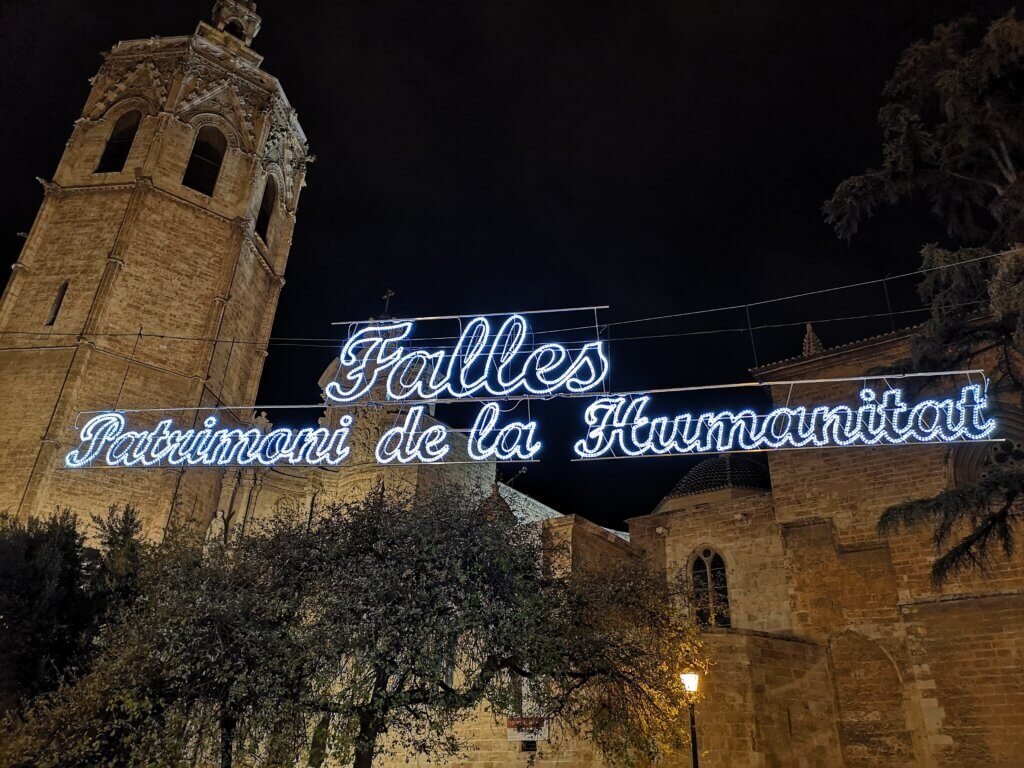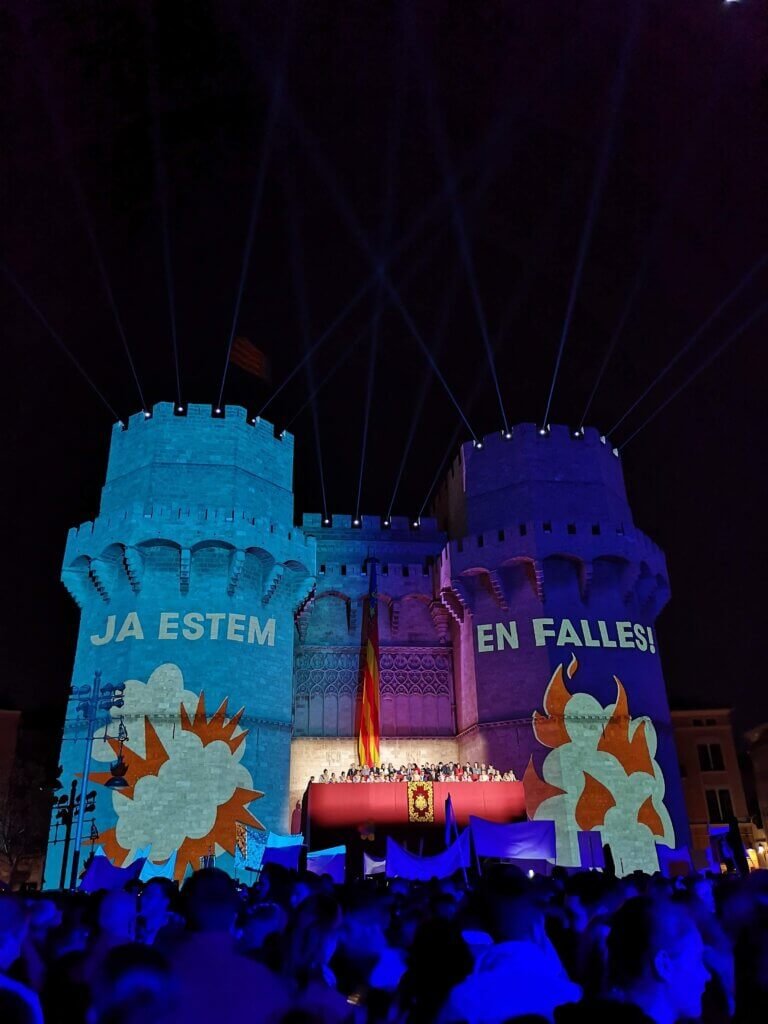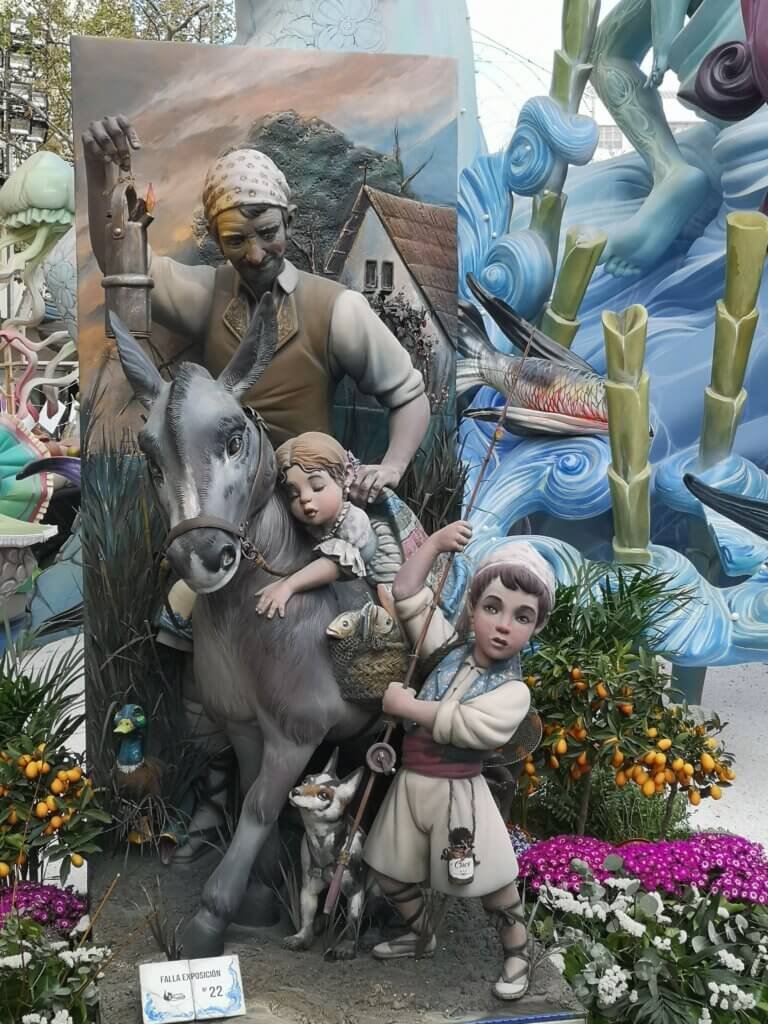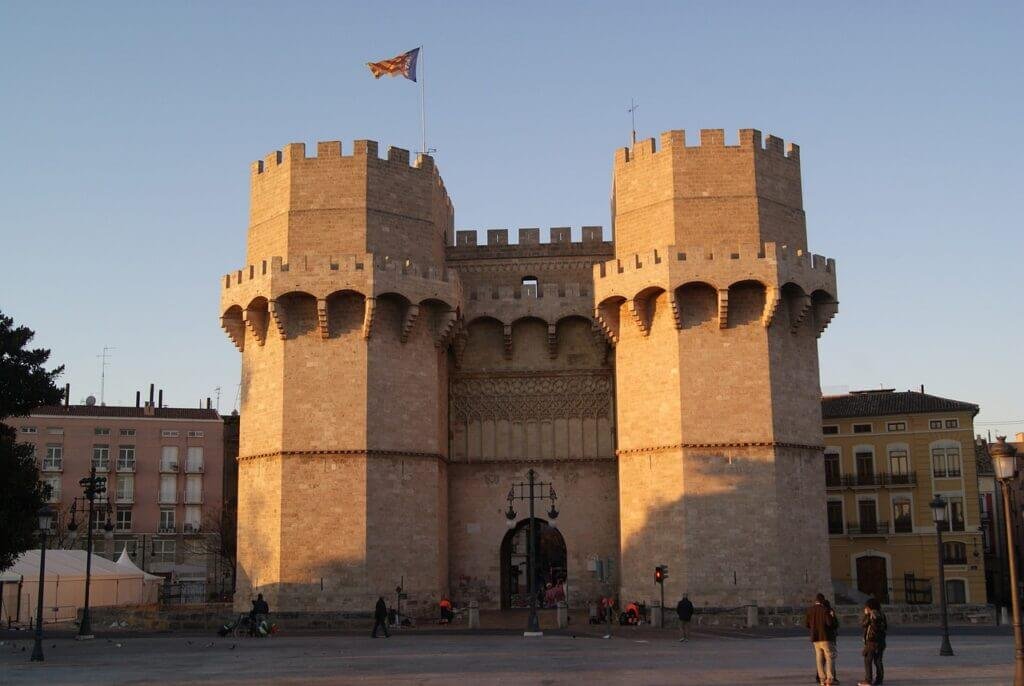This is the guide to all of the Falles vocabulary you need to understand to truly appreciate the Valencia fire festival. From the real meaning of “Fallas” to all those terms that end in “à”, here’s everything you need to celebrate Saint Joseph’s holiday like a real Valencian.

What does Fallas Mean?

The festival’s name comes from the medieval Catalan word “Falla”, which means torch.* Considering every monument (the Falla) is set on fire on the night of March 19th – it’s easy to see the logical connection.
The closest English pronunciation would be “fa-yah” [fáʎa].
There are many different concepts that use the word “Falles” or “Fallas”, meaning it can be a bit complicated for tourists. So in this guide, we’ll be going over all the unique terms that you’ll hear and read during Les Falles.
*Source: La Festa de les Falles, by the Associació d’Estudis Fallers
Is it Les Falles or Las Fallas?

Even though you’ll see “Las Fallas”, especially on social media, the most appropriate name is “Les Falles”.
Meaning Les Falles is the best way to refer to this Valencian holiday.
The reason: it’s a Valencian holiday, which comes from a Valencian/Catalan word, and is only celebrated in the Valencian Country.
(because in case you didn’t know, Spain is a multilingual State with 5 official languages).
But “Las Fallas” is a translation into Spanish. And a lot of people globally have come in contact with the translation, since Spanish-speakers outside of Valencia will refer to the festival this way.
Plus, with very few exceptions – every part of the festival takes place in Valencian: the speeches, the ceremonies, the signs, and the poetry on the monuments.
So that’s why I always stick to Les Falles, the original name in Valencian. In my opinion – it’s more authentic and genuine.
And now that we’ve gotten the most important vocabulary question out of the way – let’s move on to all the other terms you should learn.
Les Falles Vocabulary to Know
There are a lot of terms specific to Les Falles, meaning it can be difficult for tourists to understand what everything’s about!
Especially considering a lot of these words don’t have direct translations in English.
Casal

A Casal is one of the neighborhood associations, but it refers more specifically to the actual location. It comes from the word Casa – home.
Many Falles will have a private room/space/office that they use throughout the year. Most of the times it has a bar inside, as well.
And during Les Falles, this becomes the homebase for the Falla (the organization), where people will hang out, party, and enjoy the festival.
Important: these are usually private spaces, since the fallers and falleres pay dues throughout the year.
Castell
The literal translation for “Castell” means “Castle”.
But during Les Falles, Els Castells refer to the enormous firework shows that take place. These aren’t to be confused with a Mascletà, which always takes place during the day.
The Castells always take place at night, and are known for having bright displays of color.
The Nit del Foc is a special event that will have the biggest Castell of the season.
Why is it called a castle? I have absolutely no idea. My guess is that it’s because all of the fireworks reach up high in the air like a castle? Maybe?
Cavalcada del Foc
La Cavalcada del Foc takes place just a few hours before La Cremà.
This fire-filled parade is an exciting act where dancers and performers dress up as demons and mythological creatures, marching down the street in a fiery display.
Comissió Fallera
Comissió Fallera refers to the neighborhood Falla committees responsible for organizing and funding the artists that create the Falles artworks.
Sometimes these are colloquially referred to simply as a “Falla” or a “Casal”.
Cordà
La Cordà is a type of fireworks display that happens at the Plaça de l’Ajuntament.
Fireworks are wrapped around a large cord and are all set off at the same time. You’ll also see crowds of people grabbing the fireworks off the ground and tossing them into the air.
These days, the Cordà that takes place at the City Hall Square is a bit more controlled. The people who are throwing the fireworks around this 120-meter-long cord are all professionals.
But if you go to a small town, it’s not always so controlled.
Cremà

La Cremà means “The Burning”. This is the grand finale of the festival, where all the Falles are set ablaze alongside a spectacular display of fire and fireworks.
It’s the thrilling end to Les Falles, closing the cycle of the last year and leaving room to beginning anew.
Note: The accent mark is important here. La Cremà (kre-mah) means “The Burning”, while La Crema (kre-mah) means “The Cream”.
Crida

La Crida (not La Cridà) means “The Calling”.
It’s the official opening ceremony of the festival, where the Fallera Major (Festival Queen) calls on Valencians around the world to begin the celebrations.
This always takes place at the Torres dels Serrans, where you’ll see a lightshow, music, and an official public speech.
Despertà
La Despertà means “The Awakening”. In other words, this is an early morning wake-up call, where participants parade through the streets playing music and setting off firecrackers.
So every morning at 8am, you’ll be woken up so you can begin your day of festivities!
If you want to sleep in later than 8 – make sure to bring ear plugs!
Dolçaina i tabalet
These are traditional Valencian instruments you’ll hear all year long, and especially during Les Falles.
La dolçaina is a wind instrument similar to a recorder, but it has a very unique strident sound to it. El Tabalet (or El Tabal) is a percussion instrument that usually accompanies a Dolçaina player.
Falla
The most important vocabulary word for the whole festival! La Falla means “Torch” in medieval Catalan, but today it refers to a couple concepts in Saint Joseph’s festival.
Here’s what La Falla can mean:
- The monument itself. The giant artwork that can get up to 20 meters tall is La Falla
- An association. The neighborhood group organization can be referred to as a Falla or a Casal.
- The festival. Usually in plural, “Les Falles” refers to the entire holiday.
During the festival, these are the most common meanings of Falla.
Side note: The verb “Fallar” means to fail, and can also be conjugated as “Falla” or “Falles”. But this is just a (confusing) coincidence!
Fallera / Faller
La Fallera is a female participant, and El Faller is a male participant in Les Falles. Fallers and Falleres typically will wear traditional outfits that are often handmade.
Fallera Major

The Fallera Major is the “Queen” of Les Falles. One Fallera is chosen each year to represent the values and spirit of the festival. She will preside over all the major festivities throughout the entire season.
There is a different Fallera Major each year, after an intense competition.
Mascletà

La Mascletà is a daily pyrotechnic display of firecrackers that takes place at 2:00 PM at the Plaça de l’Ajuntament during the festival. These firecrackers are so loud you can hear them practically anywhere in the city.
But that doesn’t really explain the sensation of a macletà to the full extent.
Because the Mascletaes are all about the booming feeling in your chest. It’s not about seeing the fireworks, but about feeling the rhythmic beats of gunpowder that are synonymous with the festival.
Ninot

Ninot means “doll” in English.
This refers to the smaller figures or figurines that accompany the main Falla sculptures.
While the Ninots are by no means small, they are only one piece of the entire monumental scene. Many times, they serve as a representation of the theme of the overall Falla created by the artists.
Check out more details about the Exposició del Ninot (The Ninot Exhibition).
Ninot Indultat

Ninot Indultat means “The pardoned ninot”. On the night of March 19th, every single Falla throughout Valencia is burned to the ground.
All of them, except for one piece of one Falla – the Ninot Indultat.
This Ninot Indultat is decided by popular vote, and after the festival, it will take its place in the Falles Museum, along with all of its fellow winners from the last century.
Nit del Foc

La Nit del Foc, or “Night of Fire,” is a spectacular fireworks show that takes place during Les Falles.
This is the biggest fireworks display of the year, so this is one you don’t want to miss.
Usually it takes place above the Turia Gardens, but make sure to check the events schedule for the exact location.
Ofrena

L’Ofrena is a floral offering made to the Patron Saint of València – The Virgin of the Forsaken.
Hundreds of Fallers and Falleres march from their neighborhood to the Plaça de la Mare de Déu, each with a bouquet of flowers to offer up.
When they arrive at the square, they’ll be faced with an enormous statue of the Virgin Mary. Then, a team of artists will take the flowers and carry them up and place them carefully on her back.
After two days of marching, The Virgin Mary has an impressively decorated cape of flowers that fills the square.
It’s one of the most unique parts of the festival, so you definitely don’t want to miss it!
Petards/Coets
Petards (or Coets) are small firecrackers commonly used during the festival to add to the explosive atmosphere.
This is a generic term, and you might hear tons of other words for specific varieties of firecrackers. For example, the Trons de Bac are a special kind that are used during the Despertà.
Pinta i Agulles

La Pinta (or the peineta in Spanish) is the golden ornament you’ll see the Falleres wear. Les Agulles are the golden hairpins that keep it in place.
One of the most special elements of the festival is the traditional outfits and style of dress. So along with the handmade silk dresses, girls will usually adorn their hair with La Pinta.
Traditionally, these are handmade by a goldsmith, as well. So you can see there is a lot of time, craftsmanship, and money that goes into every aspect of Les Falles!
Plantà
La Plantà is the process of erecting the Falles artworks and setting them up in the streets. This always happens on the night of the 15th.
You’ll see all of the artists, Fallers, and associations meticulously putting together their multi-story masterpiece in the middle of the street.
Revetla/Verbena
A Revetla (or Verbena in Spanish) is an outdoor club/dance party that is commonplace during Les Falles. You’ll see DJs setting up in random squares throughout the city, with drink vendors nearby.
These outdoor parties will keep going until 4 in the morning. So if you have one right below your hotel, then you can either join the party or bare it out until 4.
Secció Especial

The “Special Section” refers to a group of Falles that tend to be the most impressive out of all of them.
This is because these 9 Falles have a considerably larger budget than the rest of the neighborhood organizations.
Bigger budget = Bigger Falla
That means you’ll definitely want to check these out on your Falles adventure. Here is the list of the 9 Falles:
- Falla Na Jordana
- Falla Convent de Jerusalem
- Falla Almirall Cadarso
- Falla Sueca Literat Azorín
- Falla del Regne
- Falla L’Antiga de Campanar
- Falla Exposició
- Falla Cuba Literat Azorín
- Falla El Pilar
Traca
Traca refers to a string of firecrackers or fireworks used to create loud, rapid explosions.
These are especially common during Les Falles. Lots of neighborhood associations will set up a Traca in the street to set off.
However – these take place all year long, not just in Falles!
It’s also common to set off a Traca at the end of a wedding or a baptism. So if you hear a sudden and loud explosion in the city, that’s probably why!
Valencians just love their fireworks!
Xocolatà

Xocolatà is a traditional event where people enjoy hot chocolate with their favorite Falles desserts.
Most Valencians will tell you that the only hot chocolate acceptable is thick Valor chocolate. Then you take your treats and dip them in.
You can do this whenever you’d like during Les Falles, but it’s most common during a Berenar (evening snack).
Here are the desserts you can enjoy during a Xocolatà:
- Xurros (Valencian churros)
- Bunyols (Similar, but thicker and made with pumpkin)
- Figues albardades (Battered figs)
- Coca de llanda (Poundcake)
Learn the meaning of Falles for yourself!
The best way to learn all of these Falles vocabulary terms is to experience it for yourself.
Make sure to email me if you have any questions, or check out the other guides to learn more about Les Falles and to plan your trip.


